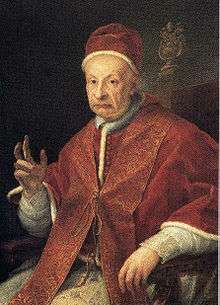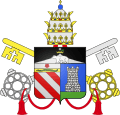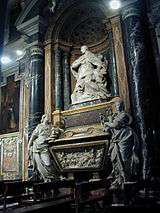Pope Benedict XIII
| Servant of God, Pope Benedict XIII | |
|---|---|
 | |
| Papacy began | 29 May 1724 |
| Papacy ended | 21 February 1730 |
| Predecessor | Innocent XIII |
| Successor | Clement XII |
| Orders | |
| Ordination |
24 February 1671 by Pope Clement X |
| Consecration |
3 February 1675 by Paluzzo Paluzzi Altieri Degli Albertoni |
| Created Cardinal |
22 February 1672 by Pope Clement X |
| Personal details | |
| Birth name | Pietro Francesco Orsini |
| Born |
2 February 1649[1] Gravina in Puglia, Kingdom of Naples |
| Died |
21 February 1730 (aged 81) Rome, Lazio, Papal States |
| Previous post |
|
| Coat of arms |
|
| Sainthood | |
| Venerated in | Roman Catholic Church |
| Title as Saint | Servant of God |
| Other popes named Benedict | |
| Ordination history of Pope Benedict XIII | |
|---|---|
Priestly ordination | |
| Ordained by | Clement X |
| Date of ordination | 24 February 1671 |
Episcopal consecration | |
| Principal consecrator | Paluzzo Card. Paluzzi (Card. Nep.) |
| Co-consecrators |
Stefano Brancaccio (Vit. & Tusc.) Costanzo Zani (Imola) |
| Date of consecration | 3 February 1675 |
Cardinalate | |
| Elevated by | Clement X |
| Date of elevation | 22 February 1672 |
Bishops consecrated by Pope Benedict XIII as principal consecrator | |
| Tiberio Muscettola | 19 May 1680 |
| Domenico Diez de Aux | 13 November 1689 |
| Fabrizio Cianci | 30 November 1689 |
| Marcello Cavalieri | 15 January 1690 |
| Giuseppe Rosa | 22 January 1690 |
| Giuseppe Ponzi | 22 January 1690 |
| Pietro Vecchia | 12 March 1690 |
| Benedict XIV | 16 July 1724 |
Pope Benedict XIII (Latin: Benedictus XIII; 2 February 1649 – 21 February 1730), born Pietro Francesco Orsini, O.P., was Pope from 29 May 1724 to his death in 1730.[2] He took the name of Vincenzo Maria Orsini when he became a Dominican friar.
In the process towards sainthood, his cause for canonization opened in 1755, but it was soon closed. It was re-opened on 21 February 1931, but it was closed once again in 1940. It was opened once more on 17 January 2004, with the official process commencing in 2012. He now has the posthumous title of Servant of God.
Early life
He was born in Gravina in Puglia to Ferdinando III Orsini, duke of Gravina, and Giovanna Frangipani della Tolfa, from Toritto. He also had a brother, Domenico. He was a member of the Orsini of Rome, the third and last member of that family to become Pope. He entered the Dominican Order and received the name of "Vincenzo Maria".
He was named, by Pope Clement X, the Cardinal-Priest of San Sisto on 22 February 1672 (allegedly against his will); later he was bishop of Manfredonia, bishop of Cesena and then archbishop of Benevento. He remained a close friend of a local mystic, Serafina di dio.
Rise to the papacy
Upon the death of Pope Innocent XIII in 1724, a conclave was convoked to elect a successor. There were four divisions in the College of Cardinals and there were no clear candidates. At the conclave, Orsini was considered one of the papabile. Orsini was then proposed to be elected because he led a modest, austere life, considered to be a pastor.
Orsini refused to be elected prior to the final ballot, explaining that he was unworthy of it. After three hours of persuasion, he surrendered to the will of the cardinals and on 29 May 1724, he was elected pontiff. He chose the regnal name of "Benedict XIII" in honour of Pope Blessed Benedict XI because he was also of the Dominican Order.
On 4 June 1724, he was crowned by Benedetto Pamphili, the cardinal protodeacon. On the following 24 September, he took possession of the Basilica of St. John Lateran.
At first, he called himself Benedict XIV, but afterwards altered the title to Benedict XIII (the previous Benedict XIII having been considered an antipope).
| Papal styles of Pope Benedict XIII | |
|---|---|
 | |
| Reference style | His Holiness |
| Spoken style | Your Holiness |
| Religious style | Holy Father |
| Posthumous style | Servant of God |
Pontificate
Early actions
The new pope caused considerable embarrassment to his aides by his constant affinity for adding personal touches to official ceremonies. For example, he prostrated himself at the door of Saint Peter's to kiss the floor; this was an innovation which completely upset the routine of the ceremony. The cortège of cardinals had no idea whether they should do the same or stand until the pope rose. The crowd behind, who thought he had collapsed, pushed and pressed to get a better view, causing many accidents and confusion. Another instance was when he refused to be carried in the Sedia Gestatoria but insisted on walking through the basilica.[3]
Actions
A man not of wordly matters, he endeavoured to put a stop to the decadent lifestyles of the Italian priesthood and of the cardinalate. He also abolished the lottery in Rome. A man fond above all of asceticism and religious celebrations, according to Cardinal Lambertini (later Pope Benedict XIV) he "did not have any idea about how to rule".[4]
The government was effectively held in his lieu by Cardinal Niccolò Coscia, who had been Benedict XIII's secretary when he was archbishop of Benevento, and who committed a long series of financial abuses at his own advantage, causing the ruin of the Papal treasure. According to Montesquieu, "All the money of Rome go to Benevento... as the Beneventani direct [Benedict's] weakness".[5]
Beatifications and canonizations
Benedict XIII beatified Bernardine of Feltre in 1728 and also beatified Peter Fourier on 20 January 1730. He also beatified Hyacintha of Mariscotti on 1 September 1726, Fidelis of Sigmaringen on 24 March 1729, Vincent de Paul on 13 August 1729 and John del Prado on 24 May 1728.
Through the process of equipollent canonization, Benedict XIII canonized Pope Gregory VII on 24 May 1728. He conferred sainthood upon Agnes of Montepulciano in 1726, Aloysius Gonzaga on 31 December 1726, Boris of Kiev in 1724, Francis Solano on 27 March 1726, Gleb in 1724, James of the Marches and Turibius of Mogroveio on 10 December 1726, John of Nepomuk on 19 March 1729, John of the Cross and Peregrine Laziosi on 27 December 1726, Margaret of Cortona on 16 May 1728 and Serapion of Algiers on 14 April 1728.
Foreign policies

In foreign politics, he struggled with John V of Portugal and the Jansenists.
Other activities
Pope Benedict XIII repealed the world wide smoking bans that had been set by Pope Urban VII back in 1590 and the one imposed by Pope Urban VIII.
Benedict XIII elevated 29 new cardinals into the cardinalate in a total of 12 consistories.
Benedict XIII, whose orders were descended from Scipione Rebiba, personally consecrated at least 139 bishops for various important European sees, including German, French, English and New World bishops. These bishops in turn consecrated bishops almost exclusively for their respective countries causing other episcopal lineages to die. As a result, more than 90% of present-day bishops trace their episcopal lineage through him to Cardinal Rebiba.[6]
With the papal bull Pretiosus dated May 26, 1727 Benedict XIII granted to all Dominicans major houses of study and in particular to the Roman College of St. Thomas, the future Pontifical University of St. Thomas Aquinas, Angelicum the right of conferring academic degrees in theology to students outside the Order.[7]
In 1727 he inaugurated the famous Spanish Steps and founded the University of Camerino.
Death and burial
Benedict XIII was suddenly attacked by a catarrh which had been bought about by officiating at the funeral service of Cardinal Marco Antonio Ansidei, of which he died of on 21 February 1730 at the age of 81. His death was made public to the people the next day.

The pope was of middling size; his countenance was mild, his nose aquiline and he had a broad forehead. At the autopsy, it was discovered that his heart was remarkably large. His funeral ceremonies were performed at the Vatican, whence he was removed to the Santa Maria sopra Minerva where he was buried in a tomb completed by Pietro Bracci and others.
Pope Benedict XIV said of Benedict XIII: "We respectfully love that pontiff who backed his carriage rather than dispute the passage with a cartman." On that occasion Benedict XIII exclaimed to his coachman: "Non ci far impicci"—"Do not involve us in a quarrel."
Meanwhile, Coscia fled from the city in the circumstance, being excommunicated under the new Pope Clement XII. He was later restored and took part in the conclaves of 1730 and 1740.
This anonymous satirical comment on Benedict XIII's death was posted at the Pasquino:
- "This tomb encloses
- the bones of a little friar:
- more than a saint's lover
- a protector of brigands"
Cause of beatification

The process for his beatification was opened in Tortona in 1755 under Pope Benedict XIV but it did not at all advance and so was stalled. On 21 February 1931, also in Tortona, the process was revitalized but the presumed doubts about the morality of the late pontiff's Cardinal Secretary of State, Cardinal Niccolò Coscia, caused its closing in 1940.
The process was reopened on 17 January 2004. The official diocesan process commenced in Rome in early 2012 and the official opening of that process was held in the Basilica of Saint John Lateran, presided by Cardinal Agostino Vallini. The postulator of the cause is the Dominican priest Francesco Maria Ricci.[8] He now has the posthumous title of Servant of God.
See also
References
-
 "Pope Benedict XIII" in the 1913 Catholic Encyclopedia.
"Pope Benedict XIII" in the 1913 Catholic Encyclopedia. - Rendina, Claudio (1993). I papi. Storia e segreti. Rome: Newton Compton.
-
 "s: Dizionario Biografico degli Italiani (1966)/Benedetto XIII, papa" in the 1966 Dizionario Biografico degli Italiani.
"s: Dizionario Biografico degli Italiani (1966)/Benedetto XIII, papa" in the 1966 Dizionario Biografico degli Italiani.
Footnotes
| Wikimedia Commons has media related to Benedictus XIII. |
- ↑ Wikisource:Catholic Encyclopedia (1913)/Pope Benedict XIII
- ↑ Pope Benedict X is now considered an antipope. At the time, however, this status was not recognized and so the man the Roman Catholic Church officially considers the tenth true Pope Benedict took the official number XI, rather than X. This has advanced the numbering of all subsequent Popes Benedict by one. Popes Benedict XI-XVI are, from an official point of view, the tenth through fifteenth popes by that name.
- ↑ "Pope Benedict XIII: Proceedings of the Conclave that led to his election". 2005. Retrieved 4 May 2014.
- ↑ Rendina, p. 590
- ↑ Rendina, p. 592
- ↑ Bransom, Charles. "Apostolic Succession in the Roman Catholic Church". mysite.verizon.net. Archived: 24 September 2014.
- ↑ http://www.liberius.net/articles/Les_colleges_ecclesiastiques_de_Rome.pdf Accessed 26, May, 2014
- ↑ "ORSINI, O.P., Vincenzo Maria". Retrieved January 22, 2014.
| Catholic Church titles | ||
|---|---|---|
| Preceded by Innocent XIII |
Pope 29 May 1724–21 February 1730 |
Succeeded by Clement XII |
| ||||||||||||||||||||||||||||||||||||||||||||||||||||||||||||||||||||||||
| ||||||||||||||||||||||||||||||||||||||||||||||||||||||
|

